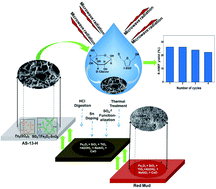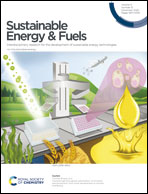Microwave induced one-pot conversion of d-glucose to 5-hydroxymethylfurfural by a novel sulfate-functionalized Sn-red mud catalyst†
Abstract
The aqueous phase conversion of D-glucose to 5-hydroxymethylfurfural (5-HMF) under microwave irradiation using a red mud (RM) based catalyst modified with Sn and H2SO4 is reported. Acid (HCl)-treated RM (ARM) exhibited a surface area almost 8.4 times higher than that of RM. The AS-x-H catalyst obtained by doping of Sn followed by functionalization of sulfate groups on ARM showed improved Lewis and Bronsted acid characteristics. The catalyst was predominantly composed of SO42−/Fe2O3–SnO2 and Fe2(SO4)3 as suggested by XRD analysis and well supported by XPS analysis. Other characterization techniques such as FESEM, FESEM-EDX, FTIR, ATR-FTIR, BET and NH3-TPD were performed for a detailed understanding of the physicochemical properties of the prepared catalysts. AS-13-H produced a 5-HMF yield of 26.22% at 180 °C and 5 min from D-glucose with water as the solvent. In the presence of a solvent consisting of dimethyl sulfoxide (DMSO) and water in a weight ratio of 1 : 1, the 5-HMF yield improved to 53.8%. The synergistic interaction of Sn (13 wt%) with the components of ARM improved the catalytic stability due to which a satisfactory 5-HMF yield was found up to the fourth use. The characteristics of the spent catalyst were studied by FTIR and FESEM-EDX analysis and discussed in detail.



 Please wait while we load your content...
Please wait while we load your content...